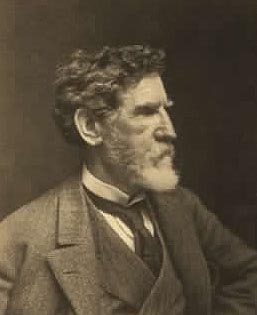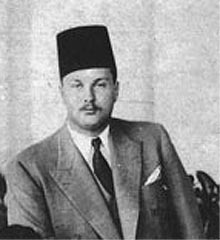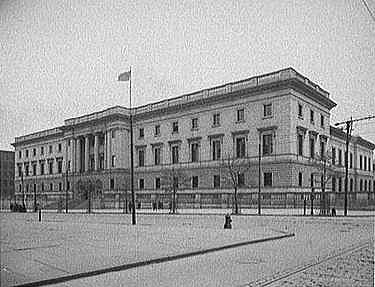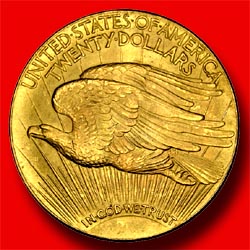pop up description layer
HOME
Cryptozoology UFO Mysteries Aviation Space & Time Dinosaurs Geology Archaeology Exploration 7 Wonders Surprising Science Troubled History Library Laboratory Attic Theater Store Index/Site Map Cyclorama
Search the Site: |
|
It was stolen from the U.S. government, collected by an eccentric king, seized by the Secret Service and practically worshiped by numismatists. Though it is not much more than an inch in diameter and weights just a bit more than an ounce, the 1933 Double Eagle is the world's most valuable coin. The story of the United States 1933 Double Eagle starts with the election of President Theodore Roosevelt in 1901. Roosevelt felt that a great nation's place in the world should be reflected in its coinage and that the United States' money didn't measure up to the country's important status. "I think our coinage is artistically of atrocious hideousness," he told Secretary of the Treasury Leslie Shaw in 1904. Roosevelt wanted the coins to be redesigned by a real artist, so in 1905 he approached Augustus Saint-Gaudens about the project. The Saint-Gaudens' Design Saint-Gaudens, born in 1848 in Ireland, immigrated to the United States as a small child and was raised in New York City. In 1876 he quickly established an artistic reputation with a statue of Civil War Admiral David Farragut in New York's Madison Square. Other assignments followed and by the beginning of the 20th century he was recognized as one of America's premier sculptors. Saint-Gaudens was honored by Roosevelt's new request; however it brought the artist into direct conflict with the obnoxious personality of Charles Barber.
Charles Barber was the chief engraver at the United States Mint in Philadelphia. The drafting of new coins and metals had always been the province of the chief engraver, but Barber's lack of talent had produced a series of uninspired designs. Extremely territorial, Barber had clashed with Saint-Gaudens already over the plans for several silver coins and the official medal of the Columbian Exposition of 1893 held in Chicago. In the case of the silver coins Barber had won by default, and with the Columbian metal Barber had managed to supplant one side of Saint-Gaudens' design with his own. The new coins, however, would afford Saint-Gaudens a chance to put Barber in his place and give the United States, as Roosevelt had put it "a coinage that would have some beauty." Two of the gold coins Saint-Gaudens would redesign were the eagle (the name of the United States $10 coin) and the double eagle (a $20 coin). For the double eagle Saint-Gaudens envisioned (as he wrote to Roosevelt) the "figure of Liberty striding forward as if on a mountain top, holding aloft on one arm a shield bearing the stars and stripes with the word Liberty marked across the field; in the other hand, perhaps a flaming torch, the drapery would be flowing in the breeze." On the reverse side would be a flying eagle. The coinage project would turn out to be one of Saint-Gaudens' last. Several years before he'd been diagnosed with cancer and in 1906 it worsened. In too poor health to translate his ideas into clay, Saint-Gaudens chose his assistant Henry Herring to do the actual work. Herring found himself blocked by Barber who continually rejected Saint-Gaudens' designs because the high relief made pressing the coin difficult. When Saint-Gaudens finally died in July of 1907 and his coin design was not in production, President Roosevelt was furious. He called on the new Secretary of the Treasury, Frank Leach, to solve the problem. Leach overruled Barber, authorized extra workmen to run the presses day and night, and produced 12,000 coins based on a high relief design. In the end another lower relief, more practical version was created for coins from 1908 onward. While these were not as spectacular as the limited 1907 run, the Saint-Gaudens series of double eagle coins were hailed as some of the most beautiful currency the United States ever made. Gold Made Illegal
Saint-Gaudens' gold coins were produced every year until 1933. A few years earlier, in 1928, the United States stock market had suffered a collapse, bringing on a period that would be known as "The Great Depression." Business slowed down, thousands of jobs were lost and many families found themselves living on the street. By 1933 people were beginning to lose faith in the banking system. Fearing the banks would fail and they would lose all their money, people ran to the bank in panic to pull their money out, usually in the form of gold coins. As banks usually did not keep all their assets in the form of gold, such a "run" on the bank could cause the bank to fail. Since all the banks were connected together with the Federal Reserve Banks and U.S. gold stores, this banking crisis could lead to further collapse of the economy. To avoid this, the incoming president, Franklin D. Roosevelt, signed legislation that would take the country off the gold standard and make it illegal for U.S. citizens to own gold. Banks could still pay out money to customers, but only paper money. This saved the U.S. economy, but was the end of millions of gold coins. Not only would the Mint not manufacture any more gold coins, successive legislation required citizens to turn in any gold that they had. This included "all gold coin, gold bullion, and gold certificates now owned by or coming into their ownership on or before April 28, 1933." The only exception to this was "gold coins having a recognized special value to collectors of rare and unusual coins." The administration declared it a citizen's patriotic duty to turn in gold for paper money and the public complied. While it had been determined that the U.S. government would not be issuing any more gold coins, someone forgot to officially notify the Mint in Philadelphia. For several months early in 1933 they labored on, pressing 445,500 new Double Eagles before the order to stop was received. These were never officially issued to the public and with the exception of two copies sent to the Smithsonian Institution, all the 1933 Double Eagles were melted down and returned to federal gold storage. Or at least that was the official story. The Switt Coins Despite never officially being issued, somehow a handful of 1933 Double Eagles came into the possession of Israel Switt, a Philadelphia jeweler and dealer in scrap gold. Switt often dealt with the Mint exchanging coins at the official window and he also was friends with George McCann, an official at the Mint. In the years between 1937 and 1941, Switt sold ten 1933 Double Eagles to coin collectors.
In 1944 one of these coins was purchased by King Farouk of Egypt. King Farouk at that time was one of the world's most notorious playboys and a collector of almost everything. His four palaces were stuffed with his various acquisitions piled up in an almost haphazard fashion. Coins especially interested Farouk. As a collector he was aware that any gold coin taken out of the United States would need an export license. In February of 1944 after the king purchased the Double Eagle he had it sent to the Mint so the export license could be issued. Mint officials, who were probably not even aware that the 1933 Double Eagles had never been officially issued, granted the license and the coin was sent to Egypt on March 11th, 1944. Though the 1933 Double Eagles were recognized as rare and valuable coins during this period, they were bought and sold among the coin dealing world without much fuss until March of 1944. It was at that point one of them came up for sale at a public auction. The sellers, the Stack brothers, generated a lot of publicity about it, which triggered the interest of Ernest Kehr, a journalist for The New York Herald Tribune. Kehr started wondering just how rare the 1933 Double Eagle was and called the Mint to find out how many had been issued to the public. When somebody at the Mint actually checked the records, they realized that no 1933 Double Eagles had ever been issued. From this it was reasoned that any of the coins held by the public must have been stolen from the Mint. After reaching this conclusion, associate Mint director LeLand Howard decided he needed to contact the United States Secret Service. The 1944 Seizures While people usually associate the Secret Service with protecting the President, the organization's original charter was to prevent counterfeiting and ensure the integrity of U.S. currency. Secret Service agent Harry Strang was assigned to the case and tracked down each of the owners of a known 1933 Double Eagle, making them turn the coin over to him voluntarily, or seizing it from them by legal means. Coin collectors and dealers were shocked. There had been a long history of coins that had left the Mint under questionable circumstances and the owners of these had never been punished by seizure before. This change in policy was most likely the result of the appointment of Frank Wilson to the head of the Secret Service in 1936. Wilson had worked as a detective for years and was responsible for resolving a number of high-level cases including the Lindbergh kidnapping, the arrest and conviction of corrupt politician Huey Long and the capture of gangster Al Capone. Under him the Secret Service zealously went after cases they might have never tackled in the past. This included cases which in retrospect seem trivial. The Strang investigation centered on George McCann, a Mint official, Israel Switt, the jeweler and Edward Silver, Switt's business partner and brother-in-law. Though Strang suspected the three had colluded to steal the coins from the Mint, they were never charged because the statute of limitations had run out.
After 1944 the only known 1933 Double Eagle that had not been seized by the government and melted down (with the exception of the two at the Smithsonian) was the one owned by King Farouk. Several letters requesting that the coin be returned were drafted over the years, but the State Department overruled the Treasury on this matter and they were never sent. The State Department did not wish to upset relations with an important foreign head of state over the matter of a small gold coin. By 1952 the King had lost the support of most of his people and was deposed in a coup and exiled to live the rest of his life in Italy and Monaco. His collections, including the 1933 Double Eagle, were left in Egypt and were seized by the new government. The British auction house Sotheby was contracted to dispose of most of these treasures. In 1954, the Double Eagle was listed to be sold along with other coins in the King's collection, but was withdrawn after a protest from the American government. The Egyptians decided not to sell it, but neither did they return it to the Americans. Instead, it disappeared from sight for over forty years. The Legendary Farouk Eagle Found It wasn't until 1995 that the coin, which by then had almost become a legend, resurfaced. British coin dealers Stephen Fenton and Andre de Clermont had been working with an Egyptian jeweler to liquidate the extensive coin collection of an Egyptian military officer. The officer had been quite an avid collector, but after he had died his children decided to sell his collection. De Clermont had noticed that many of the coins coming from the collection had once belonged to Farouk. This prompted him to ask about the 1933 Double Eagle. The jeweler was at first reluctant to talk about the coin, but then appeared with it in his possession. Fenton, working through de Clermont, bought the 1933 Double Eagle plus a few other gold coins from the Egyptian for $220,000. Fenton was aware that if he took the Double Eagle to the United States it might be subject to seizure, so he wanted to find a buyer outside America and sell it quietly, rather than at public auction. To do this he worked with a Kansas City coin dealer named Jay Parrino. Parrino did find a customer that was willing to pay $1,650,000 for the rare coin, but Fenton would have to be willing to bring the coin to New York. Fenton relented and arranged a meeting to do the exchange at the Waldorf-Astoria Hotel on February 8th, 1996. The deal went off as promised, but then both Fenton and Parrino were arrested. The buyer, a man from Amarillo, Texas, named Jack Moore, had been an informant for the United States Secret Service.
The U.S. government had its coin back, but would they keep it? The charges against Parrino and Fenton were dropped because prosecutors realized it was too difficult to prove that they had known the coin was stolen government property. With his client's freedom assured, Fenton's lawyer, Barry Berke, concentrated on getting the coin back. The government's main problem with establishing ownership of the Double Eagle had to do with the amount of time that had passed since it had disappeared from the Mint. Records existed that seemed to show that none of the coins could have possibly left the Mint by legitimate means, but most of the witnesses involved had died. Faced with the possibility of losing the case, the Treasury Department decided to cut a deal with Fenton: They would settle the case by officially issuing the coin, selling it and splitting the profits with him. Fenton accepted this arrangement and the auction houses of Sotheby and Stacks, who had lost their opportunity to sell Double Eagles in 1944 and 1954, were chosen to auction it off. The excitement surrounding the auction in the coin world was tremendous. The Farouk 1933 Double Eagle would now be the only one in the world that could legally be owned by a private person. The date for the sale was set for July 30th, 2002, just one day before the annual meeting of the American Numismatic Association. This ensured that all the important coin dealers would be in New York City to witness the historic event. The most that had ever been paid for a coin before this was $4.1 million for a United States 1804 silver dollar. Observers expected that this Double Eagle, with its odd history, would go for much more. The bidding for the 1933 Double Eagle started at $2.5 million and ended at $7,590,000, making it the most valuable coin in the world. The coin ended up in the hands of an anonymous bidder, who loaned it to the American Numismatic Society to be displayed at the New York Federal Reserve Bank where it can still be seen today. Other 1933 Double Eagles Was the Farouk coin the last of the Double Eagles? As it turns out, no. The excitement created by the sale of the Farouk coin caused the decedents of Israel Switt to search his Philadelphia shop carefully. They found ten more 1933 Double Eagles which they were forced to turn over to the government. Switt's decedents hired Barry Berke, Fenton's lawyer, to see if they could make these newly-found coins legal too, but so far the Treasury Department seems to have no intention of making a deal. Without the Farouk export license, the case for Switt's decedents may be weaker than the case Fenton had. There is also rumored to be at least one 1933 Double Eagle being held illegally in a private collection. This is a one-of-a-kind treasure for the person who owns it, but he can never publically acknowledge its existence as that would soon bring the United States Secret Service to his door. So it appears the only legal 1933 Double Eagle is the Farouk coin. In the end, it is just a tiny piece of stamped metal. Was it really worth all the fuss? What really makes the coin valuable isn't just the ounce of gold in it, but the strange history behind it. A Partial Bibliography Illegal Tender: Gold, Greed, and the Mystery of the Lost 1933 Double Eagle, by David Tripp, Free Press, 2004. United States Mint Recovers 10 Famed Double Eagles, United States Mint Website, June 2008, http://www.usMint.gov/pressroom/index.cfm?flash=yes&action=press_release&ID=607 Double Eagle: Epic Story of the World's Most Valuable Coin, by Alison Frankel, W.W. Norton & Company, 2006 |
|
Related Links |
|
|



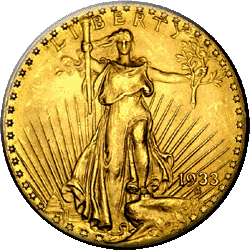 The
Most Valuable Coin in the World: The 1933 Double Eagle
The
Most Valuable Coin in the World: The 1933 Double Eagle
